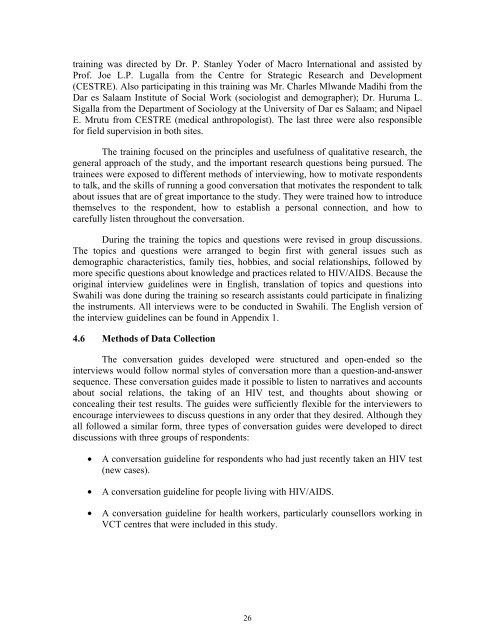social context of disclosing hiv test results: hiv testing in tanzania
social context of disclosing hiv test results: hiv testing in tanzania
social context of disclosing hiv test results: hiv testing in tanzania
You also want an ePaper? Increase the reach of your titles
YUMPU automatically turns print PDFs into web optimized ePapers that Google loves.
tra<strong>in</strong><strong>in</strong>g was directed by Dr. P. Stanley Yoder <strong>of</strong> Macro International and assisted by<br />
Pr<strong>of</strong>. Joe L.P. Lugalla from the Centre for Strategic Research and Development<br />
(CESTRE). Also participat<strong>in</strong>g <strong>in</strong> this tra<strong>in</strong><strong>in</strong>g was Mr. Charles Mlwande Madihi from the<br />
Dar es Salaam Institute <strong>of</strong> Social Work (sociologist and demographer); Dr. Huruma L.<br />
Sigalla from the Department <strong>of</strong> Sociology at the University <strong>of</strong> Dar es Salaam; and Nipael<br />
E. Mrutu from CESTRE (medical anthropologist). The last three were also responsible<br />
for field supervision <strong>in</strong> both sites.<br />
The tra<strong>in</strong><strong>in</strong>g focused on the pr<strong>in</strong>ciples and usefulness <strong>of</strong> qualitative research, the<br />
general approach <strong>of</strong> the study, and the important research questions be<strong>in</strong>g pursued. The<br />
tra<strong>in</strong>ees were exposed to different methods <strong>of</strong> <strong>in</strong>terview<strong>in</strong>g, how to motivate respondents<br />
to talk, and the skills <strong>of</strong> runn<strong>in</strong>g a good conversation that motivates the respondent to talk<br />
about issues that are <strong>of</strong> great importance to the study. They were tra<strong>in</strong>ed how to <strong>in</strong>troduce<br />
themselves to the respondent, how to establish a personal connection, and how to<br />
carefully listen throughout the conversation.<br />
Dur<strong>in</strong>g the tra<strong>in</strong><strong>in</strong>g the topics and questions were revised <strong>in</strong> group discussions.<br />
The topics and questions were arranged to beg<strong>in</strong> first with general issues such as<br />
demographic characteristics, family ties, hobbies, and <strong>social</strong> relationships, followed by<br />
more specific questions about knowledge and practices related to HIV/AIDS. Because the<br />
orig<strong>in</strong>al <strong>in</strong>terview guidel<strong>in</strong>es were <strong>in</strong> English, translation <strong>of</strong> topics and questions <strong>in</strong>to<br />
Swahili was done dur<strong>in</strong>g the tra<strong>in</strong><strong>in</strong>g so research assistants could participate <strong>in</strong> f<strong>in</strong>aliz<strong>in</strong>g<br />
the <strong>in</strong>struments. All <strong>in</strong>terviews were to be conducted <strong>in</strong> Swahili. The English version <strong>of</strong><br />
the <strong>in</strong>terview guidel<strong>in</strong>es can be found <strong>in</strong> Appendix 1.<br />
4.6 Methods <strong>of</strong> Data Collection<br />
The conversation guides developed were structured and open-ended so the<br />
<strong>in</strong>terviews would follow normal styles <strong>of</strong> conversation more than a question-and-answer<br />
sequence. These conversation guides made it possible to listen to narratives and accounts<br />
about <strong>social</strong> relations, the tak<strong>in</strong>g <strong>of</strong> an HIV <strong>test</strong>, and thoughts about show<strong>in</strong>g or<br />
conceal<strong>in</strong>g their <strong>test</strong> <strong>results</strong>. The guides were sufficiently flexible for the <strong>in</strong>terviewers to<br />
encourage <strong>in</strong>terviewees to discuss questions <strong>in</strong> any order that they desired. Although they<br />
all followed a similar form, three types <strong>of</strong> conversation guides were developed to direct<br />
discussions with three groups <strong>of</strong> respondents:<br />
• A conversation guidel<strong>in</strong>e for respondents who had just recently taken an HIV <strong>test</strong><br />
(new cases).<br />
• A conversation guidel<strong>in</strong>e for people liv<strong>in</strong>g with HIV/AIDS.<br />
• A conversation guidel<strong>in</strong>e for health workers, particularly counsellors work<strong>in</strong>g <strong>in</strong><br />
VCT centres that were <strong>in</strong>cluded <strong>in</strong> this study.<br />
26

















